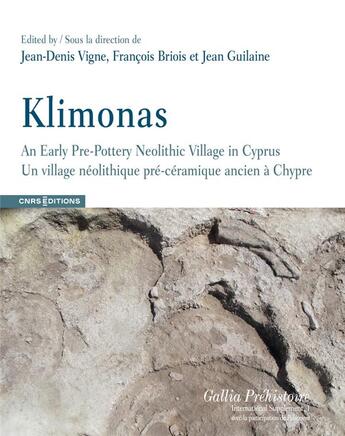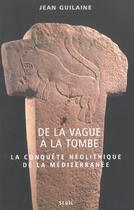Résumé:
Klimonas An Early Pre-Pottery Neolithic Village in Cyprus Un village néolithique pré-céramique ancien à Chypre Klimonas is the oldest Mediterranean island village. Occupied ca. 8 800 cal BC, it postpones by several centuries the Neolithic presence in Cyprus, at that time located more than 80 km... Voir plus
Klimonas An Early Pre-Pottery Neolithic Village in Cyprus Un village néolithique pré-céramique ancien à Chypre Klimonas is the oldest Mediterranean island village. Occupied ca. 8 800 cal BC, it postpones by several centuries the Neolithic presence in Cyprus, at that time located more than 80 km offshore.
The village extended over more than 5,500 mÇ, facing the sea, 2 km from the famous pre-pottery site of Shillourokambos and near rich flint outcrops. Excavations (2009-2016) revealed that it was composed of circular or oval earthen buildings 3-6 m in diameter, notched into the slope, modestly fitted out and organised around a semi-buried 10 m communal building.
The construction techniques, the abundance of either knapped or polished stone material, together with ornaments, symbolic objects, and plants and animal remains, as well as the 52 radiometric dates, point to the end of the Levantine Pre-Pottery Neolithic A (PPNA). The presence of a communal building, rebuilt numerous times over the course of several decades, also points to the same conclusion.
The villagers gathered seeds and fruits and cultivated wild starch and einkorn, recently imported from the continent.
They primarily hunted small endemic wild boar, the only large mammal species attested on the island at that time and, secondarily, birds. They did not eat fish or marine shellfish. Domestic dogs, mice and cats brought from the continent also lived in the village.
The remains of this cultivator-hunter community testify to the early extension of the Near Eastern Neolithic and to unsuspected seafaring skills, substantially improving our knowledge of the Neolithic transition in the Mediterranean.
Klimonas est le plus ancien village insulaire de Méditerranée. Occupé autour de 8 800 av. n.è., il recule de plusieurs siècles le début de la présence néolithique à Chypre, à cette époque déjà située à plus de 80 km du continent.
Le village s'étendait sur 5 500 mÇ au moins, face à la mer, à 2 km du célèbre site pré-céramique de Shillourokambos et au contact de riches sources de silex. Les fouilles (2009-2016) ont montré qu'il était composé d'édifices de terre crue (bauge) de 3 à 6 m de diamètre, circulaires ou ovalaires, encochés dans la pente, modestement aménagés, organisés autour d'un bâtiment communautaire semi-enterré de 10 m de diamètre.
Les techniques de construction, l'abondant mobilier de pierre taillée, le macro-outillage, les parures et objets symboliques, les restes de plantes et les ossements animaux, tout comme les 52 datations radiométriques renvoient à la fin du Néolithique pré-céramique A levantin (PPNA). La présence d'un bâtiment communautaire, plusieurs fois reconstruit en quelques décennies, le confirme.
Les villageois pratiquaient la cueillette et cultivaient l'amidonnier et l'engrain sauvages, récemment importés du continent. Ils chassaient un petit sanglier endémique, seule espèce de grand mammifère attestée sur l'île à cette époque, et, secondairement, des oiseaux. Poissons et coquillages marins n'étaient pas consommés. Des chiens domestiques, des souris et des chats de souche continentale vivaient dans le village.
Les vestiges de cette communauté d'agriculteurs-chasseurs témoignent de l'extension précoce du premier Néolithique du Proche-Orient et d'une maîtrise insoupçonnée de la navigation. Il enrichit de manière substantielle nos connaissances sur la transition néolithique en Méditerranée.










